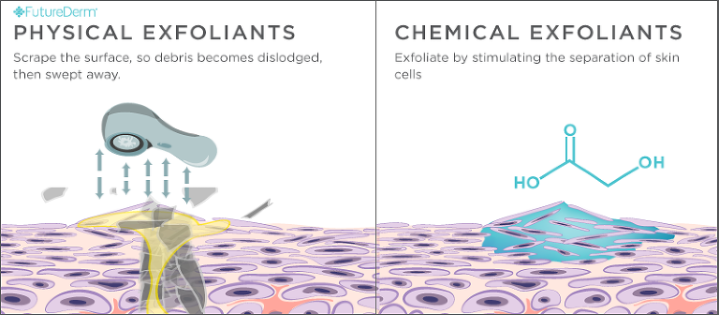No edit summary |
(Layout and paragraph text) |
||
| Line 1: | Line 1: | ||
[[Category:Skin Care]] | [[Category:Skin Care]] | ||
== | == Exfoliation == | ||
Exfoliation is the process of encouraging the renewal of skin cells by removing dead skin cells from the surface of the skin. This is achieved by either chemical (topical products) or physical (topical products and cosmetic tools) exfoliation. Exfoliating is important for promoting healthy skin and increasing the efficacy of other skincare products, but they require ''careful'' and ''periodic'' use. | |||
There are many signs that skin can benefit from exfoliation, such as clogged pores, dullness, texture, roughness, uneven tone and frequent breakouts. | |||
[[File:Exfoliants.png|left|thumb|719x719px|https://www.majormag.in/physical-vs-chemical-exfoliation-peels-and-scrubs/]] | |||
=== '''Chemical Exfoliation''' === | |||
Chemical Exfoliation is one of the two main categories that exfoliating products fall into. Most chemical exfoliants work by breaking down the glue or bonds between dead skin cells and promoting its shedding. Chemical exfoliants can be further categorized into '''AHAs''' (alpha hydroxy acids), '''PHAs''' (poly hydroxy acids), which are water-soluble chemicals, '''BHAs''' (beta hydroxy acids), which are lipid-soluble chemicals and '''enzyme''' exfoliants. | |||
=== Types of Chemical Exfoliants === | |||
The most common type of '''BHA''' is '''salicylic acid''', a common ingredient that possesses the obvious exfoliating mechanism, but is simultaneously anti-inflammatory, nonetheless '''salicylic acid''' penetrates deeper than other exfoliants due to its solubility and can paradoxically cause more irritation. The most common types of '''AHAs''' are '''glycolic, lactic and mandelic,''' which are also common exfoliants that possess hydrating properties alongside exfoliating. The most common types of '''PHAs''' are '''gluconolactone and lactiobionic''' '''acid''', they are referred to as the next generation of '''AHAs''', due to less irritating, more hydrating effects, but possess weaker exfoliating action. | |||
=== Choosing Chemical Exfoliants === | |||
Choosing the right chemical exfoliant product depends on skin concerns, most skin types will benefit from leave on treatments, such as toners, serums and moisturisers that contain exfoliants. Sensitive and irritated skin types will benefit from wash off treatments, such as cleansers or masks that contain exfoliants. When using a leave on treatment product containing an exfoliant, it is recommended to use 1-3x a week, preferably at night, without layering or mixing other exfoliating products. When using a wash off treatment product containing an exfoliant, it is recommended to leave the product on the skin for 1-5 minutes before rinsing off, to ensure penetration of the ingredients. Due to the differing solubility and mechanisms between chemical exfoliants, products containing them should be chosen for specific skin concerns It is often recommended that oily, combination and acne prone skin types should lean towards '''BHA''' usage and dry and normal skin types should lean towards '''AHA''' usage. If skin is sensitive or compromised, '''PHAs, mandelic acid''' or '''enzymes''' should be used instead. | |||
=== Serums === | === Serums === | ||
Serums are special products which address specific problems and improve different aspects of the skin. | Serums are special products which address specific problems and improve different aspects of the skin. | ||
Revision as of 22:29, 4 December 2023
Exfoliation
Exfoliation is the process of encouraging the renewal of skin cells by removing dead skin cells from the surface of the skin. This is achieved by either chemical (topical products) or physical (topical products and cosmetic tools) exfoliation. Exfoliating is important for promoting healthy skin and increasing the efficacy of other skincare products, but they require careful and periodic use.
There are many signs that skin can benefit from exfoliation, such as clogged pores, dullness, texture, roughness, uneven tone and frequent breakouts.

Chemical Exfoliation
Chemical Exfoliation is one of the two main categories that exfoliating products fall into. Most chemical exfoliants work by breaking down the glue or bonds between dead skin cells and promoting its shedding. Chemical exfoliants can be further categorized into AHAs (alpha hydroxy acids), PHAs (poly hydroxy acids), which are water-soluble chemicals, BHAs (beta hydroxy acids), which are lipid-soluble chemicals and enzyme exfoliants.
Types of Chemical Exfoliants
The most common type of BHA is salicylic acid, a common ingredient that possesses the obvious exfoliating mechanism, but is simultaneously anti-inflammatory, nonetheless salicylic acid penetrates deeper than other exfoliants due to its solubility and can paradoxically cause more irritation. The most common types of AHAs are glycolic, lactic and mandelic, which are also common exfoliants that possess hydrating properties alongside exfoliating. The most common types of PHAs are gluconolactone and lactiobionic acid, they are referred to as the next generation of AHAs, due to less irritating, more hydrating effects, but possess weaker exfoliating action.
Choosing Chemical Exfoliants
Choosing the right chemical exfoliant product depends on skin concerns, most skin types will benefit from leave on treatments, such as toners, serums and moisturisers that contain exfoliants. Sensitive and irritated skin types will benefit from wash off treatments, such as cleansers or masks that contain exfoliants. When using a leave on treatment product containing an exfoliant, it is recommended to use 1-3x a week, preferably at night, without layering or mixing other exfoliating products. When using a wash off treatment product containing an exfoliant, it is recommended to leave the product on the skin for 1-5 minutes before rinsing off, to ensure penetration of the ingredients. Due to the differing solubility and mechanisms between chemical exfoliants, products containing them should be chosen for specific skin concerns It is often recommended that oily, combination and acne prone skin types should lean towards BHA usage and dry and normal skin types should lean towards AHA usage. If skin is sensitive or compromised, PHAs, mandelic acid or enzymes should be used instead.
Serums
Serums are special products which address specific problems and improve different aspects of the skin.